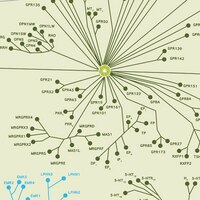Tachykinin NK2 receptor antagonists for the treatment of irritable bowel syndrome.
Lecci, Alessandro, et al.
Br. J. Pharmacol., 141: 1249-63 (2004)
2004
Show Abstract
Tachykinin NK2 receptors are expressed in the gastrointestinal tract of both laboratory animals and humans. Experimental data indicate a role for these receptors in the regulation of intestinal motor functions (both excitatory and inhibitory), secretions, inflammation and visceral sensitivity. In particular, NK2 receptor stimulation inhibits intestinal motility by activating sympathetic extrinsic pathways or NANC intramural inhibitory components, whereas a modulatory effect on cholinergic nerves or a direct effect on smooth muscle account for the NK2 receptor-mediated increase in intestinal motility. Accordingly, selective NK2 receptor antagonists can reactivate inhibited motility or decrease inflammation- or stress-associated hypermotility. Intraluminal secretion of water is increased by NK2 receptor agonists via a direct effect on epithelial cells, and this mechanism is active in models of diarrhoea since selective antagonists reverse the increase in faecal water content in these models. Hyperalgesia in response to intraluminal volume signals is possibly mediated through the stimulation of NK2 receptors located on peripheral branches of primary afferent neurones. NK2 receptor antagonists reduce the hyper-responsiveness that occurs following intestinal inflammation or application of stressful stimuli to animals. Likewise, NK2 receptor antagonists reduce intestinal tissue damage induced by chemical irritation of the intestinal wall or lumen. In healthy volunteers, the selective NK2 antagonist nepadutant reduced the motility-stimulating effects and irritable bowel syndrome-like symptoms triggered by intravenous infusion of neurokinin A, and displayed other characteristics that could support its use in patients. It is concluded that blockade of peripheral tachykinin NK2 receptors should be considered as a viable mechanism for decreasing the painful symptoms and altered bowel habits of irritable bowel syndrome patients. | 15037522
 |
The tachykinin peptide family.
Severini, Cinzia, et al.
Pharmacol. Rev., 54: 285-322 (2002)
2002
Show Abstract
The tachykinin peptide family certainly represents one of the largest peptide families described in the animal organism. So far, more than 40 tachykinins have been isolated from invertebrate (insects, worms, and molluscs), protochordate, and vertebrate (skin, gastrointestinal tract, peripheral and central nervous system) tissues. Substance P (SP), first identified by bioassay as early as 1931 but sequenced only in 1971, several years after the elucidation of the structure of eledoisin from molluscan tissues and of physalaemin from amphibian skin, may be considered as a prototype of the tachykinins. Hitherto, as many as 19 tachykinins have been isolated from amphibian integument, and eight additional peptides have been isolated from amphibian gut and brain. Counterparts of skin tachykinins in mammalian tissues are SP, neurokinin A, and neurokinin B. Three main receptor subtypes for the tachykinins have been identified (NK1, NK2, and NK3), but their number is probably destined to increase. It is obvious that the peripheral and central effects of the tachykinins may substantially vary depending on the activation of different receptor subtypes. Matters are further complicated by the frequent capacity of the single tachykinins to bind, although with different affinity, to more receptors. It has been recognized that tachykinins have a variety of effects in physiological and pathological conditions, and there is evidence suggesting intrinsic neuroprotective and neurodegenerative properties of these neuropeptides. This review provides an update on the current body of knowledge regarding tachykinin occurrence and distribution in the animal kingdom, from the lowest invertebrates to man, and the physiological and pharmacological actions of tachykinins outlining the pregnant importance of this large peptide family. | 12037144
 |












